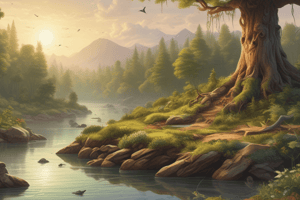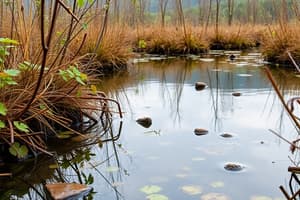Podcast
Questions and Answers
Which set of components is exclusively abiotic?
Which set of components is exclusively abiotic?
- Animals, microorganisms, and solar radiation
- Plants, animals, and microorganisms
- Light, water, and nutrients in soil (correct)
- Plants, water, and wind
An ecosystem is a biological community in a specific locale interacting only with other living organisms.
An ecosystem is a biological community in a specific locale interacting only with other living organisms.
False (B)
What is the fundamental process through which producers create their nourishment?
What is the fundamental process through which producers create their nourishment?
photosynthesis
The term 'Ecosystem' was first proposed by A.G. _________ in 1935.
The term 'Ecosystem' was first proposed by A.G. _________ in 1935.
What is the original meaning of the Greek word 'Oikos', from which the term ecology is derived?
What is the original meaning of the Greek word 'Oikos', from which the term ecology is derived?
Consumers, like animals, can synthesize their food directly from sunlight.
Consumers, like animals, can synthesize their food directly from sunlight.
Match the following ecosystem components with their roles:
Match the following ecosystem components with their roles:
Which of the following best illustrates the relationship between ecology and ecosystems?
Which of the following best illustrates the relationship between ecology and ecosystems?
Which of the following best describes the fundamental difference between a grazing food chain and a detritus food chain?
Which of the following best describes the fundamental difference between a grazing food chain and a detritus food chain?
A significant impact on one species within a food web will only affect the tropic level directly above it.
A significant impact on one species within a food web will only affect the tropic level directly above it.
Describe how food chains and food webs contribute to maintaining ecological balance in an ecosystem.
Describe how food chains and food webs contribute to maintaining ecological balance in an ecosystem.
The increasing concentration of non-biodegradable materials as they move up through the tropic levels is known as ______.
The increasing concentration of non-biodegradable materials as they move up through the tropic levels is known as ______.
Match each ecological pyramid type with what it represents:
Match each ecological pyramid type with what it represents:
In a grassland ecosystem, the pyramid of numbers is typically upright. What does this indicate about the relationship between producers and consumers?
In a grassland ecosystem, the pyramid of numbers is typically upright. What does this indicate about the relationship between producers and consumers?
A pyramid of energy can be inverted, similar to a pyramid of biomass.
A pyramid of energy can be inverted, similar to a pyramid of biomass.
Explain why there is a decrease in biomass from lower to higher tropic levels in a forest ecosystem.
Explain why there is a decrease in biomass from lower to higher tropic levels in a forest ecosystem.
The pyramid of energy illustrates the amount of ______ needed to support each successive tropic level.
The pyramid of energy illustrates the amount of ______ needed to support each successive tropic level.
Which of the following best describes the relationship between food chains and food webs?
Which of the following best describes the relationship between food chains and food webs?
Which of the following equations represents photosynthesis?
Which of the following equations represents photosynthesis?
Which type of consumer directly feeds on plants?
Which type of consumer directly feeds on plants?
Which of the following organisms is classified as a secondary consumer?
Which of the following organisms is classified as a secondary consumer?
Detritivores obtain nutrients by consuming dead organic matter.
Detritivores obtain nutrients by consuming dead organic matter.
Which of the following is an example of an abiotic component of an ecosystem?
Which of the following is an example of an abiotic component of an ecosystem?
Elements like carbon, hydrogen, and oxygen are examples of ______ substances in an ecosystem.
Elements like carbon, hydrogen, and oxygen are examples of ______ substances in an ecosystem.
A cropland is an example of which type of ecosystem?
A cropland is an example of which type of ecosystem?
What is the primary function of an ecosystem?
What is the primary function of an ecosystem?
Which function of an ecosystem involves the distribution of energy in the form of food to all consumers?
Which function of an ecosystem involves the distribution of energy in the form of food to all consumers?
According to the first law of thermodynamics, energy cannot be created or destroyed, but it can be...
According to the first law of thermodynamics, energy cannot be created or destroyed, but it can be...
Energy transfer between trophic levels is 100% efficient.
Energy transfer between trophic levels is 100% efficient.
The sequence of eating and being eaten in an ecosystem is known as a ______.
The sequence of eating and being eaten in an ecosystem is known as a ______.
Approximately what percentage of potential energy is lost as heat at each trophic level?
Approximately what percentage of potential energy is lost as heat at each trophic level?
Match each trophic level with its correct description:
Match each trophic level with its correct description:
What is the primary role of decomposers (T5) in an ecosystem?
What is the primary role of decomposers (T5) in an ecosystem?
Flashcards
Ecology
Ecology
The study of interactions between organisms and their environment.
Abiotic Components
Abiotic Components
Non-living components of the environment, such as light, water, and nutrients.
Biotic Components
Biotic Components
Living organisms in the environment, such as plants, animals, and microorganisms.
Ecosystem
Ecosystem
Signup and view all the flashcards
Producers (Autotrophs)
Producers (Autotrophs)
Signup and view all the flashcards
Consumers
Consumers
Signup and view all the flashcards
Decomposers
Decomposers
Signup and view all the flashcards
Photosynthesis
Photosynthesis
Signup and view all the flashcards
Grazing Food Chain
Grazing Food Chain
Signup and view all the flashcards
Detritus Food Chain
Detritus Food Chain
Signup and view all the flashcards
Food Web
Food Web
Signup and view all the flashcards
Function of Food Chains and Webs
Function of Food Chains and Webs
Signup and view all the flashcards
Bio-magnification
Bio-magnification
Signup and view all the flashcards
Ecological Pyramid
Ecological Pyramid
Signup and view all the flashcards
Pyramid of Numbers
Pyramid of Numbers
Signup and view all the flashcards
Pyramid of Biomass
Pyramid of Biomass
Signup and view all the flashcards
Pyramid of Energy
Pyramid of Energy
Signup and view all the flashcards
Energy Loss in Trophic Levels
Energy Loss in Trophic Levels
Signup and view all the flashcards
Heterotrophs (Consumers)
Heterotrophs (Consumers)
Signup and view all the flashcards
Primary Consumers (Herbivores)
Primary Consumers (Herbivores)
Signup and view all the flashcards
Secondary Consumers (Primary Carnivores)
Secondary Consumers (Primary Carnivores)
Signup and view all the flashcards
Tertiary Consumers (Secondary Carnivores)
Tertiary Consumers (Secondary Carnivores)
Signup and view all the flashcards
Omnivores
Omnivores
Signup and view all the flashcards
Detritivores
Detritivores
Signup and view all the flashcards
Natural Ecosystems
Natural Ecosystems
Signup and view all the flashcards
Artificial Ecosystems
Artificial Ecosystems
Signup and view all the flashcards
Function of an Ecosystem
Function of an Ecosystem
Signup and view all the flashcards
Food Chain
Food Chain
Signup and view all the flashcards
Trophic Levels
Trophic Levels
Signup and view all the flashcards
1st Law of Thermodynamics (in ecosystems)
1st Law of Thermodynamics (in ecosystems)
Signup and view all the flashcards
Study Notes
- Ecology is the study of interactions among organisms and their environment
- The environment consists of both biotic (living organisms) and abiotic (non-living organisms) components
Origin of the Term Ecology
- German biologist Haeckel coined the term "ecology" in 1869
- Ecology is derived from the Greek words ‘Oikos’ (house, habitat) and ‘Logos’ (to study)
- Danish botanist Eugenius Warming expanded on the concept of ecology
Interactions Studied in Ecology Include:
- Non-living components: light, water, wind, soil nutrients, heat, solar radiation, atmosphere
- Living organisms: plants, animals, microorganisms in the soil
Ecosystem Defined
- A.G. Tansley introduced the term "ecosystem" in 1935
- An ecosystem is a biological community in a specific location and the physical and chemical factors that make up its non-living environment
- Examples include ponds, deserts, forests, and oceans
- Ecosystems are the basic functional units of ecology
- An ecosystem is a community of different species interacting with each other and their non-living environment, exchanging energy and matter
Ecology Focus
- Ecology specifically studies ecosystems
- Animals rely on plants for food, either directly or indirectly
Ecosystem Structure Components
- Ecosystems have biotic (living) and abiotic (non-living) components
Biotic Components
- Biotic components include all living organisms in an ecosystem
- Examples are plants, animals, and microorganisms
Classification of Biotic Components by Food Source:
- Producers (Autotrophs): plants
- Consumers (Heterotrophs): animals
- Decomposers: micro-organisms
Producers (Autotrophs)
- Producers synthesize their own food through photosynthesis
- Examples include green plants and trees
Photosynthesis
- Chlorophyll in plant leaves converts carbon dioxide and water into carbohydrates using sunlight
- The chemical equation is: 6CO2 + 6H2O ----> C6H12O6 + 6O2
Consumers (Heterotrophs)
- Consumers classification:
- Primary Consumers (Herbivores): Plant eaters like insects, rats, goats, deer, cows
- Secondary Consumers (Primary Carnivores): Meat eaters that feed on herbivores, such as frogs, cats, snakes, and small birds
- Tertiary Consumers (Secondary Carnivores): Meat eaters that feed on secondary consumers, such as hawks, eagles, tigers, and lions
- Omnivores: Organisms that eat both plants and animals, like humans, rats, and birds
- Detritivores: Organisms that feed on dead organisms, wastes, and partially decomposed matter, like termites, earthworms, and ants
Decomposers
- Decomposers break down dead producers and consumers into simpler compounds releasing inorganic nutrients
- Producers then use these nutrients to synthesize their own food
- Examples: bacteria and fungi
Abiotic Components
- Non-living components (physical and chemical) form the abiotic community
- Examples include climate, soil, water, and air
- Physical components: energy, climate, nutrients, and living space needed by the biological community
- Examples: air, water, soil, and sunlight
- Chemical Components: sources of essential nutrients
- Organic substances: proteins, lipids, and carbohydrates
- Inorganic substances: micro (Al, Co, Zu, Cu) and macro elements (C,H, O, P, N, P, K)
Types of Ecosystems
- Natural ecosystems: operate under natural conditions
- Terrestrial ecosystems: related to land (e.g., grasslands, forests, deserts)
- Aquatic ecosystems: related to water
- Fresh water ecosystems:
- Running water (rivers, streams)
- Standing water (ponds, lakes)
- Marine ecosystems: seas and seashores
- Fresh water ecosystems:
- Man-made (artificial) ecosystems: maintained by humans (e.g., croplands, gardens)
Ecosystem Functions
- Allow the flow of energy and the cycling of nutrients
Three Main Functions
- Primary: Starch manufacture (photosynthesis)
- Secondary: Distributing energy as food to all consumers
- Tertiary: Cycling, where dead systems decompose
Studying Ecosystem Functioning by Examining
- Energy and material flow
- Food chains
- Food webs
- Food pyramids
Energy Flow in Ecosystems
- Energy flow is the most essential requirement for all living organisms
- Solar energy is the primary source
- Solar energy is converted to chemical energy by plants during photosynthesis
- Plants use some chemical energy for growth, and the rest is transferred to consumers through eating
- Energy enters ecosystems through photosynthesis, passing through different tropic levels or feeding levels
- The flow of energy in an ecosystem follows the laws of thermodynamics
Laws of Thermodynamics
- First law: Energy cannot be created or destroyed, only converted from one form to another
- Energy from the sun is absorbed by plants and converted into chemical energy, then transformed into heat by consumers
- Second law: Energy is lost as heat during transformation
- Energy is transferred between tropic levels as heat due to respiration, work, running, and hunting
- The energy and nutrient flow cycle from abiotic to biotic and back
Food Chains
- A food chain is the sequence of eating and being eaten in an ecosystem, or the transfer of food energy through a series of organisms
- It always starts with plant life and ends with an animal; microorganisms decompose dead organisms into nutrients that plants reuse
- About 80-90% of potential energy is lost as heat at each level
Tropic Levels
- Tropic levels are the steps through which food energy passes
- Green plants (producers) are the first tropic level (T1)
- Herbivores (primary consumers) are the second tropic level (T2)
- Carnivores (secondary consumers) are the third tropic level (T3)
- Tertiary consumers are the fourth tropic level (T4)
- Decomposers are the last tropic level (T5)
Types of Food Chains
- Grazing food chain: starts with green plants and goes to decomposers through herbivores and carnivores; found in grassland and pond ecosystems
- Detritus food chain: starts with dead organic matter and goes to decomposers through herbivores and carnivores; found in grassland and forest ecosystems; grazing and detritus food chains are interconnected
Food Webs
- A food web is the interlocking pattern of various food chains in an ecosystem, where different organisms are connected at different tropic levels
- Food webs offer multiple opportunities for eating and being eaten at each tropic level
Differences Between Food Chains and Food Webs
- In a food chain, if one species is affected or becomes extinct, the subsequent tropic levels are also affected
- In a food web, the impact is less severe due to multiple options at each tropic level
Significance of Food Chains and Food Webs
- Both play a vital role in ecosystems
- Energy flow and nutrient cycling take place through them
- They maintain and regulate population sizes, helping to maintain ecological balance
- They exhibit bio-magnification, where non-biodegradable materials accumulate at increasing concentrations at higher tropic levels
Ecological Pyramids
- Ecological pyramids are graphical representations of the structure and function of tropic levels, starting with producers at the bottom and successive tropic levels forming the apex
- Biomass and the number of organisms decrease from producers to consumers
- Energy is lost as heat at each tropic level, making the pyramid progressively smaller near the top
Types of Ecological Pyramids
- Pyramid of numbers
- Pyramid of energy
- Pyramid of biomass
Pyramid of Numbers
- Represents the number of individual organisms at each tropic level
- In a grassland ecosystem, grasses (producers) are large in number at the lower tropic level
- Rats (primary consumers) are fewer in number at the second tropic level
- Snakes (secondary consumers) are even fewer at the third tropic level
- Eagles (tertiary consumers) are the fewest at the top level
Pyramid of Biomass
- A graphical representation of biomass (mass or weight of biological material) in a unit area at each tropic level
- Shows the relationship between biomass and tropic level
Example
- A forest ecosystem shows a decrease in biomass from lower to higher tropic levels
- Trees (producers) contribute the most biomass
- Herbivores (rabbits, deer) and carnivores (snakes, foxes) have less biomass
- Tertiary consumers (lions, tigers) have the lowest biomass
Pyramid of Energy
- Indicates the amount of energy flow at each level
- Illustrates how much energy is needed to support the next tropic level
- There is always a significant loss of energy
Studying That Suits You
Use AI to generate personalized quizzes and flashcards to suit your learning preferences.





